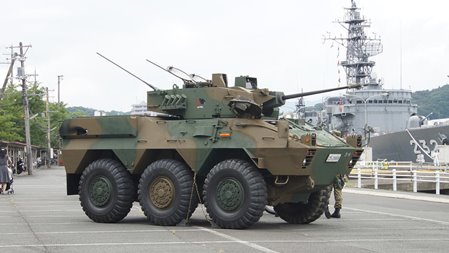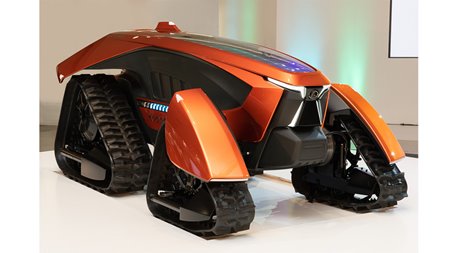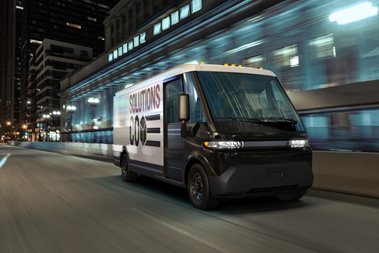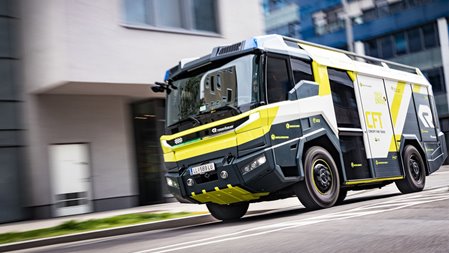7 Ways Electric Vehicle Technology is Changing the World
7 Ways Electric Vehicle Technology is Changing the World


Electric vehicles are penetrating more than fleets of passenger vehicles, from construction to combat and more.
As electric vehicles gain in popularity on roadways, industries are taking note. New electric concepts not only can reduce a company’s carbon footprint, but the high tech features that come with new age vehicles are enticing. Here are seven ways that electric vehicle technology is shaping the way our world works.
“We're really in that learning phase right now,” said Michael Sprang, project manager of the Joint Program Office of Joint Light Tactical Vehicles, in a March 4 webinar. “What is in the realm of possibility relative to commercial industry and where they've taken electrification, and how can electrification fill a military requirement.”
Electrifying larger military vehicles like tanks and cargo trucks will take much longer, due to their size and power requirements. But, the eLRV is an important step forward.
John Deere’s GridCON is fully autonomous, equipped with 1,000 meters of cable, and a robotic arm that ensures that the cable doesn’t get stuck or cause too much friction. A built-in GPS allows the tractor to efficiently clear fields and it can even be guided via remote control should the farmer have a special job.
More for You: Inforgraphic: The Electrical Components of the Self-Driving Car
Kubota’s X Tractor concept is also fully autonomous and uses artificial intelligence for precision farming, which includes reading the weather to calculate best times to plant and perform other actions. The information it gathers can also be communicated to other machines on site to ensure a central-managed operation.
With a shortage of farm workers and huge corporations running many of today’s farming operations, electric machinery will be essential to the ever growing population’s need for agricultural goods and services.
Many companies are finding that excavators are a good place to start. Volvo’s ECR25 Electric Excavator can run for up to four hours on one charge. Proterra and Komatsu have teamed up to launch their own electric excavator, which combines the Proterra battery with Komatsu’s reputation for mining equipment. The companies claim it reduces noise and emissions, making for a cleaner, healthier alternative to traditional excavation equipment.
Overall, construction is one of the biggest polluting industries in the world. But as residential and commercial development continues, even small changes to the technology construction crews use will have a huge impact.
FedEx has taken an interest in GM’s BrightDrop for its shipping needs. Their electric cargo van, the EV600, can travel up to 250 miles before needing a charge and can carry up to 2,200 pounds. All vans come equipped with a security system and motion sensors, including motion-activated LED lighting, as well as a range of other high-tech features.
Reader’s Choice: Advancing Battery Technology for Modern Innovations
BYD is churning out electric buses, taxis, monorails, and even garbage trucks to solve transportation challenges for cities across the U.S. BYD currently has 40,000 electric buses in service around the world and has contracts with companies like Anheuser-Busch that want to offset its carbon footprint.
Unlike other industries, trucking is getting a huge investment from the electric vehicle industry. Daimler just unveiled its semi-truck concept, the eCascadia, which will be able to achieve 250 miles off one charge. The truck will be entering production in 2022.
With so many people wanting items shipped right to their door, these vehicles will solve last-mile challenges that so many companies face, and electric alternatives make it an even better investment.
Lightning eMotors and REV Group Inc. are collaborating on a fleet of all-electric ambulances, slated for delivery by the end of 2021. According to Tim Reeser, CEO of Lightning eMotors, “Electrification is reaching all different types of fleet vehicles, and ambulances are a logical next step.”
Rosenbaur’s Concept Fire Truck is fully electric and has a host of features, including an ergonomic design and a crawler, which is a remote-controlled robot that can carry heavy objects to the scene. A built-in wireless control panel and wifi allows for increased communications and even drone capabilities. The City of Los Angeles has ordered at least one of these trucks to use in the Hollywood area.
New designs for emergency response hold promise beyond just electrification. With added technology benefits, more lives could be saved.
PepsiCo purchased 100 Tesla Semis to add to their fleet, 15 of which will be delivered in 2021. According to Tesla, the semi has four independent motors that provide maximum power and acceleration. The semi can travel up to 500 miles on a single charge and has enhanced autopilot features, making it safer for drivers. This investment will help PepsiCo meet its aggressive carbon neutral goals.
Editor’s Pick: 3D-Printed Lithium-Ion Battery Could Power Electric Vehicles, Drones
Companies are also developing electric refrigeration vans. ThermoKing’s EV200 has advanced telematics that can monitor the temperature inside the chamber so that perishable goods arrive fresh and preserved.
Nissan is tapping into the camper and “vanlife” lifestyles with their new fully electric NV200, which can be modified with a pop top to make for comfortable sleeping accommodations. This electric option is competitively priced compared to the more expensive electric cargo van options, making it appealing to a wider audience.
For those who love the water, Hinkley’s Dasher Concept yacht has a lightweight design and is whisper silent. It utilizes BMW i3 lithium ion batteries and has dual 50 amp charging cables that allow it to charge twice as fast as an electric car.
Getting dirty is the name of the game for the Fisker Ocean, a fully electric off-road vehicle that can withstand all kinds of terrain. It is also made from recycled materials, making it environmentally friendly in more ways than one. The Fisker Ocean will be in production beginning in 2022.
Electric is becoming cost effective, efficient, and eye-catching. Although engineering electric alternatives for some heavier vehicles may still be a challenge, industries will soon have no choice but to make way for this technology.
Cassie Kelly is an independent writer based in Columbus, Ohio.
Register for our upcoming webinar series: Driving Toward the Automotive Future
Combat
The U.S. Army is always looking for new innovations and with electric vehicle technology, they wouldn’t have to rely on sourcing and transporting as much fuel. The National Defense Industrial Association’s Tactical Wheeled Vehicles Division announced it will be contracting with private companies to develop electric combat vehicles, specifically a state-of-the-art electric Light Reconnaissance Vehicle (eLRV) with the goal of implementing an entire fleet of 225,000 LRVs over the course of the next decade. Without an internal combustion engine, an eLRV would be quieter, making it ideal for stealth missions. It also would accelerate quicker and generally need less power to go longer distances. There is still the question of how to power them, but even if they had to be charged with diesel generators, they’d be a better alternative to traditional gas guzzlers.
“We're really in that learning phase right now,” said Michael Sprang, project manager of the Joint Program Office of Joint Light Tactical Vehicles, in a March 4 webinar. “What is in the realm of possibility relative to commercial industry and where they've taken electrification, and how can electrification fill a military requirement.”
Electrifying larger military vehicles like tanks and cargo trucks will take much longer, due to their size and power requirements. But, the eLRV is an important step forward.
Agriculture
Farmers are finding that electric vehicles offer lower production costs and more sustainable solutions to grow their crops. With every major brand coming out with electric models, farmers are beginning to upgrade and it is paying off. New tractor models from John Deere and Kubota not only boast higher power capabilities, but have many new features that improve efficiency on the fields.
John Deere’s GridCON is fully autonomous, equipped with 1,000 meters of cable, and a robotic arm that ensures that the cable doesn’t get stuck or cause too much friction. A built-in GPS allows the tractor to efficiently clear fields and it can even be guided via remote control should the farmer have a special job.
More for You: Inforgraphic: The Electrical Components of the Self-Driving Car
Kubota’s X Tractor concept is also fully autonomous and uses artificial intelligence for precision farming, which includes reading the weather to calculate best times to plant and perform other actions. The information it gathers can also be communicated to other machines on site to ensure a central-managed operation.
With a shortage of farm workers and huge corporations running many of today’s farming operations, electric machinery will be essential to the ever growing population’s need for agricultural goods and services.
Construction
Conceptualizing electric construction machinery may still be too far-fetched given the sheer size and power that most construction vehicles require, but some companies are starting to bridge the gap.
Many companies are finding that excavators are a good place to start. Volvo’s ECR25 Electric Excavator can run for up to four hours on one charge. Proterra and Komatsu have teamed up to launch their own electric excavator, which combines the Proterra battery with Komatsu’s reputation for mining equipment. The companies claim it reduces noise and emissions, making for a cleaner, healthier alternative to traditional excavation equipment.
Overall, construction is one of the biggest polluting industries in the world. But as residential and commercial development continues, even small changes to the technology construction crews use will have a huge impact.
Freight
Your package has to get you somehow. FedEx, UPS, DHL, and Amazon have all committed to electrifying their fleets and investing in the companies that can make it happen. From cargo vans to forklifts, almost every aspect of the freight industry can be transformed.
FedEx has taken an interest in GM’s BrightDrop for its shipping needs. Their electric cargo van, the EV600, can travel up to 250 miles before needing a charge and can carry up to 2,200 pounds. All vans come equipped with a security system and motion sensors, including motion-activated LED lighting, as well as a range of other high-tech features.
Reader’s Choice: Advancing Battery Technology for Modern Innovations
BYD is churning out electric buses, taxis, monorails, and even garbage trucks to solve transportation challenges for cities across the U.S. BYD currently has 40,000 electric buses in service around the world and has contracts with companies like Anheuser-Busch that want to offset its carbon footprint.
Unlike other industries, trucking is getting a huge investment from the electric vehicle industry. Daimler just unveiled its semi-truck concept, the eCascadia, which will be able to achieve 250 miles off one charge. The truck will be entering production in 2022.
With so many people wanting items shipped right to their door, these vehicles will solve last-mile challenges that so many companies face, and electric alternatives make it an even better investment.
Emergency Response
Medics, firefighters, and first responders may soon be coming to your door in an all-electric vehicle. Reliability is key when it comes to emergency response, and many companies are taking the leap to reimagining the traditional designs of ambulances, fire trucks, police cruisers, and more.
Lightning eMotors and REV Group Inc. are collaborating on a fleet of all-electric ambulances, slated for delivery by the end of 2021. According to Tim Reeser, CEO of Lightning eMotors, “Electrification is reaching all different types of fleet vehicles, and ambulances are a logical next step.”
Rosenbaur’s Concept Fire Truck is fully electric and has a host of features, including an ergonomic design and a crawler, which is a remote-controlled robot that can carry heavy objects to the scene. A built-in wireless control panel and wifi allows for increased communications and even drone capabilities. The City of Los Angeles has ordered at least one of these trucks to use in the Hollywood area.
New designs for emergency response hold promise beyond just electrification. With added technology benefits, more lives could be saved.
Food and Beverage
The restaurant industry in the United States is worth $899 billion and sourcing food and beverage products for chains and mom and pop diners alike is a robust challenge.
PepsiCo purchased 100 Tesla Semis to add to their fleet, 15 of which will be delivered in 2021. According to Tesla, the semi has four independent motors that provide maximum power and acceleration. The semi can travel up to 500 miles on a single charge and has enhanced autopilot features, making it safer for drivers. This investment will help PepsiCo meet its aggressive carbon neutral goals.
Editor’s Pick: 3D-Printed Lithium-Ion Battery Could Power Electric Vehicles, Drones
Companies are also developing electric refrigeration vans. ThermoKing’s EV200 has advanced telematics that can monitor the temperature inside the chamber so that perishable goods arrive fresh and preserved.
Travel and Leisure
Fittingly, the travel and leisure industry is having the most fun when it comes to electric vehicle technology. With a wide range of adventure vehicles coming onto the market, buyers may soon find themselves making the switch to electric.
Nissan is tapping into the camper and “vanlife” lifestyles with their new fully electric NV200, which can be modified with a pop top to make for comfortable sleeping accommodations. This electric option is competitively priced compared to the more expensive electric cargo van options, making it appealing to a wider audience.
For those who love the water, Hinkley’s Dasher Concept yacht has a lightweight design and is whisper silent. It utilizes BMW i3 lithium ion batteries and has dual 50 amp charging cables that allow it to charge twice as fast as an electric car.
Getting dirty is the name of the game for the Fisker Ocean, a fully electric off-road vehicle that can withstand all kinds of terrain. It is also made from recycled materials, making it environmentally friendly in more ways than one. The Fisker Ocean will be in production beginning in 2022.
Electric is becoming cost effective, efficient, and eye-catching. Although engineering electric alternatives for some heavier vehicles may still be a challenge, industries will soon have no choice but to make way for this technology.
Cassie Kelly is an independent writer based in Columbus, Ohio.
Register for our upcoming webinar series: Driving Toward the Automotive Future












